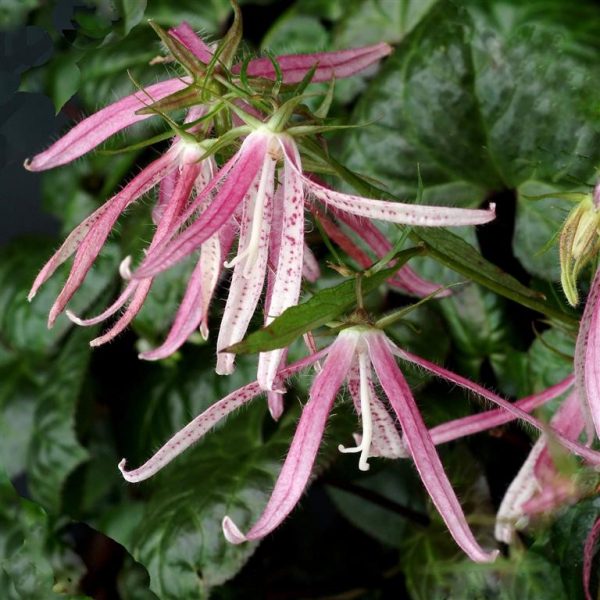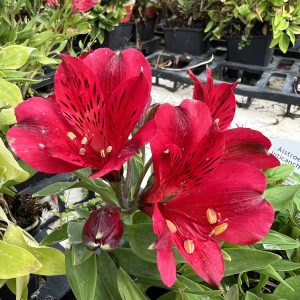PLEASE NOTE: YOUR PLANTS MAY BE SUPPLIED CUT BACK
Campanula ‘Pink Octopus’
£6.45
A clump-forming perennial with lantern shaped buds opening to unusual spidery, rose-pink spotted flowers from May to July. Height 45cm. Spread 60cm. Full sun/part shade. Moist, well-drained soil. Hardy. Attracts bees.
Description
Campanula ‘Pink Octopus’ is a striking perennial that features unique spidery, rose-pink flowers, adding beauty to any garden. To ensure your Campanula ‘Pink Octopus’ thrives, follow these helpful planting and care tips.
PLANTING and AFTERCARE GUIDE
Best Planting Time
- Spring: The best time to plant Campanula ‘Pink Octopus’ is in early spring when the soil begins to warm. This allows the roots to establish firmly, leading to a strong and healthy plant ready to bloom in the summer months.
- Autumn: Alternatively, planting Campanula in early autumn gives the plant a chance to settle in before the cooler months and encourages fresh growth when spring arrives.
Site Selection
- Sunlight: Campanula thrives in full sun to partial shade. It requires at least 4-6 hours of sunlight each day to grow well, but it can also tolerate some shade, especially during the hottest part of the day.
- Soil: Campanula prefers moist, well-drained soil that is rich in organic matter. This plant does not do well in waterlogged soil, so it’s essential to ensure proper drainage to prevent root rot. If your soil is clay-heavy, amend it with compost or well-rotted manure for better drainage.
Planting Instructions
- Prepare the Hole: Dig a hole for your Campanula ‘Pink Octopus’ that is twice the width and the same depth as the root ball. This allows the plant enough space to spread and establish its roots.
- Soil Preparation: Mix organic matter like compost into the soil to improve fertility and drainage. Campanula flourishes in nutrient-rich soil, which encourages healthy foliage and abundant blooms.
- Planting: Place the plant in the hole, ensuring that the top of the root ball is level with the surrounding soil. Backfill the hole gently, firming the soil to eliminate air pockets.
- Watering: After planting, water well to settle the soil and encourage root establishment. Keep the soil moist but not soggy as the plant settles in.
Watering Requirements
- Growing Season: Campanula prefers consistently moist soil during its growing season. Water regularly, ensuring the soil doesn’t dry out completely. However, avoid overwatering as this can lead to root rot.
- Dormant Season: During the dormant season, reduce watering significantly. Water only when the soil feels dry to the touch.
Feeding
- Spring: Apply a balanced, slow-release fertiliser in early spring to promote strong growth and flowering. This gives your Campanula the nutrients it needs to thrive.
- Mid-Summer: A light application of liquid fertiliser can help maintain healthy blooms and foliage throughout the growing season.
Pruning
- Deadheading: Regularly remove spent flowers from your Campanula to encourage continuous blooming and maintain a tidy appearance. Deadheading can also help prevent self-seeding and keep the plant’s energy focused on producing fresh flowers.
- Autumn Pruning: After the last blooms have faded, cut the plant back to the ground in autumn to prepare it for winter. This will encourage healthy regrowth in the spring.
Mulching
- Spring: Apply a layer of mulch around the base of your Campanula to retain moisture and suppress weeds. Organic mulch like bark chips or compost works best for this purpose.
- Winter: In colder months, a light mulch layer can help protect the roots from frost. Be sure not to pile the mulch too high against the plant stems.
Supporting the Plant
- Staking: While Campanula ‘Pink Octopus’ typically has sturdy stems, consider staking if the plant is grown in an area with strong winds or heavy rainfall to prevent damage to its delicate flowers.
Final Tips
Campanula ‘Pink Octopus’ is a low-maintenance perennial that adds a touch of whimsy to any garden. By planting it in well-drained, moist soil, and ensuring it gets enough sunlight, this Campanula will reward you with beautiful blooms from May to July. Regular deadheading and pruning will keep your plant healthy, and a little mulch will ensure it thrives year after year. Incorporate this unique plant into your garden for an eye-catching display that attracts bees and butterflies.
Additional information
| Pot Size |
|---|











Susan T. (verified owner) –
I purchased a selection of plants and all were healthy, strong, beautiful plants and received very quickly – I am very pleased with them. Such a shame that so many plastic bags and extra plastic pots were wasted in the packaging